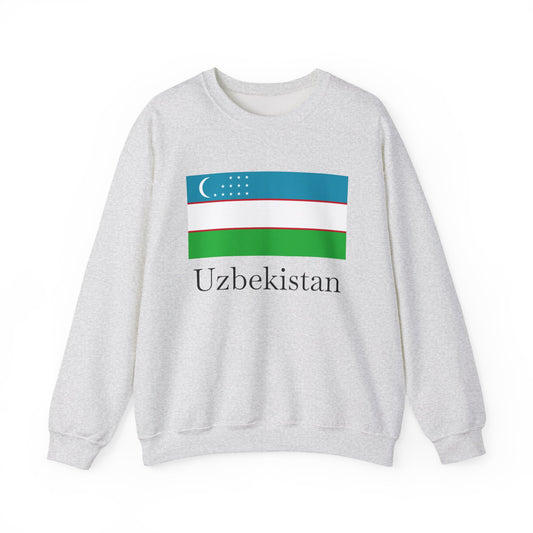-
Uzbekistan Sweatshirt
Regular price $34.15 USDRegular priceUnit price / per -
Uzbekistan Flag Sweatshirt
Regular price $34.15 USDRegular priceUnit price / per -
Uzbekistan Pillow
Regular price $22.65 USDRegular priceUnit price / per -
Uzbekistan Leather Patch Hat
Regular price $18.85 USDRegular priceUnit price / per -
Uzbekistan Mug
Regular price $11.65 USDRegular priceUnit price / per -
Uzbekistan Trucker Cap
Regular price $14.90 USDRegular priceUnit price / per -
Uzbekistan Hoodies
Regular price $34.40 USDRegular priceUnit price / per -
Uzbekistan T-shirt
Regular price $22.79 USDRegular priceUnit price / per -
Uzbekistan Flag Hoodies
Regular price $34.40 USDRegular priceUnit price / per -
Uzbekistan Flag on T-shirt
Regular price $22.79 USDRegular priceUnit price / per
Collection: Uzbekistan
The Uzbekistan flag, also known as the flag of Uzbekistan, symbolizes national pride and identity for the Central Asian country. We will explore its history, symbolism, and current relevance.
Overview of the Uzbekistan Flag

The national emblem of Uzbekistan is characterized by a vibrant tricolor arrangement featuring horizontal bands of blue, white, and green. Positioned on the upper hoist-side corner is a crescent moon flanked by twelve stars, all set against the blue band. This configuration is not just a random selection of colors and elements but a deliberate choice that reflects the nation's essence and values.
The arrangement and symbols embedded within the flag's design are carefully chosen, echoing the country's rich heritage and the natural beauty of its landscapes. Each color and symbol is deeply significant, collectively portraying a narrative of peace, purity, and prosperity. The presence of the crescent and stars, in particular, resonates with the spiritual and temporal aspirations of the Uzbek people, linking them to the broader Islamic cultural sphere. Since its adoption, this flag has served as a beacon of national identity, embodying the Uzbek nation's aspirations and pride.
Historical Context of the Uzbekistan Flag
The journey toward creating and adopting the Uzbekistan flag began amidst the profound transformations sweeping across Central Asia following the dissolution of the Soviet Union. Seizing the winds of change, Uzbekistan declared its independence on September 1, 1991. In the wake of this momentous event, there was a pressing need for symbols that could encapsulate the nation’s newfound autonomy, rich history, and aspirations for the future. Consequently, the Uzbekistan flag was adopted on November 18, 1991, serving as a national emblem and a beacon for the country's path forward.
This flag marked a significant departure from Uzbekistan’s previous flags, particularly those under Soviet rule, which featured symbols of communism and Soviet authority. Adopting a new flag symbolized Uzbekistan's break from the Soviet past and its steps toward crafting a distinct national identity. The design process sought to embed the country's deep historical roots and cultural heritage within the flag while also projecting a vision of unity and progress. As such, the chosen symbols and colors reflect a reverence for tradition and an embrace of the future. This blend of past and future, encapsulated in the flag, mirrors the nation's journey through centuries of history, from the days of the Silk Road to its current status as a sovereign state navigating the complexities of the 21st century.
Symbolism Behind the Uzbekistan Flag

Delving into the symbolism of the Uzbekistan flag reveals a rich tapestry of meanings that reflect the nation's identity, beliefs, and aspirations. The top blue stripe is a homage to the endless skies and vast bodies of water that signify tranquility and eternal peace, resonating with the country's desire for harmony within and beyond its borders. Beneath the blue lies the white stripe, symbolic of purity and the significance of cotton, a cornerstone of the Uzbek economy, to its agricultural wealth. The green stripe at the bottom echoes the verdant landscapes of Uzbekistan, a nod to its agricultural abundance and the earth's fertility.
Central to the flag's design is the crescent moon, a universal symbol of Islam that underscores the Uzbek people's spiritual connection and cultural heritage. Accompanying the crescent are twelve stars, which not only illuminate the sky but also serve as metaphors for the Islamic calendar's twelve months. This celestial ensemble highlights the importance of time, change, and renewal in the nation's collective consciousness. Together, these elements weave a narrative of a people deeply connected to their land, faith, and the cycles of nature, embodying their aspirations for a future marked by peace, purity, and prosperity.
Current Relevance of the Uzbekistan Flag
Today, the Uzbekistan flag continues to hold a place of great significance within the country, symbolizing national identity and unity and pride among its citizens. It features prominently in a wide array of contexts, from governmental buildings to educational institutions, embodying the spirit and values of the nation. During national holidays, such as Independence Day and Navruz, the flag is displayed with particular prominence, serving as a focal point for celebrations and communal gatherings. Furthermore, it plays a critical role in international diplomacy and events, representing Uzbekistan on the global stage and fostering a sense of national solidarity and recognition. Within military contexts, the flag is revered, marking ceremonies and parades with solemn respect and honor for the country's history and armed forces. This continuous and varied use of the flag underscores its enduring relevance and importance in contemporary Uzbek society, symbolizing the nation's past achievements, present endeavors, and future aspirations.
Additional Facts About the Uzbekistan Flag
Regarding the customs surrounding the Uzbekistan flag, there are stringent rules to ensure its representation reflects the nation's respect and pride. Display protocols dictate that the flag must be prominently positioned and never allowed to drag or lay upon the ground, showcasing the esteem in which it is held. It is raised with great ceremony, often accompanied by the national anthem, especially during significant national events, ensuring that the act of hoisting the flag is imbued with a sense of gravity and national unity.
In addition to these ceremonial practices, it's noteworthy that the flag's design was meticulously chosen to signify more than just the national identity; each element was selected for its deep cultural and historical resonance. This thoughtful curation extends to the flag's handling, where specific guidelines are followed to preserve its sanctity and symbolic value.
An intriguing protocol involves the correct folding and storage of the flag, ensuring it remains pristine and respected even when not on display. This level of care underscores the flag's importance as more than a national emblem—it is a cherished symbol of Uzbekistan's sovereignty, heritage, and people's aspirations.




















